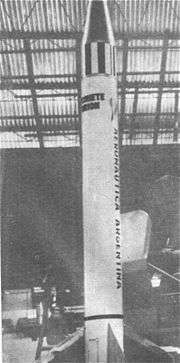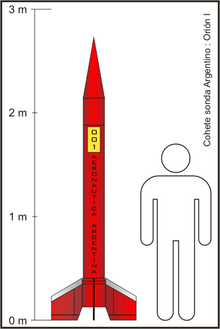Orión (rocket)
Orión was the designation of a sounding rocket of Argentina, [1] which was started between 1965 and 1971 at CELPA, Mar Chiquita, Tartagal and Wallops Island.[2] In November 1966, three tests of the Argentine-built Orion rockets took place. [3]
 | |
| Country of origin | Argentina |
|---|---|
| Date | 1965 |
| Designer | Instituto de Investigaciones Aeronauticas y Espaciales |
| Status | Retired |
| sounding rocket | |

Developed by the Instituto de Investigaciones Aeronauticas y Espaciales (IIAE), [4] Orión marked Argentina's entry into the club of space-faring nations.[5]
The Orión-2 had a gross takeoff mass of 100 kg (220 lb) and could carry a 25-kilogram (55 lb) payload. Its dimensions were 3.77 m (12.4 ft) in length and 0.21 m (8.3 in) in diameter. It could reach a ceiling of 160 km (99 mi).[6] The first version Orión-1 was flown twice in 1965 and 1966 in order to test the engines and technologies; with a length of 3.00 m (9.84 ft) it was limited to a 10-kilogram (22 lb) payload.[7] The production version Orión-2 was launched 22 times from 1966 to 1971.[6][2]
References
- NASA Sounding Rockets, 1958 - 1968: A Historical Summary. Scientific and Technical Information Office, National Aeronautics and Space Administration. 1971.
- Krebs, Gunter. "Orión-1 /-2". Gunter's space page. Retrieved 29 May 2016.
- SP-4401 - NASA SOUNDING ROCKETS, 1958-1968: A Historical Summary.The National Aeronautics and Space Administration.
- Argentina. Secretaría de Difusión y Turismo. 1970.
- "IIAE Orion". Encyclopedia Astronautica. Retrieved 29 May 2016.
- "Orion-2". Encyclopedia Astronautica. Retrieved 29 May 2016.
- "Orion-1". Encyclopedia Astronautica. Retrieved 29 May 2016.